#London Transport Executive
Explore tagged Tumblr posts
Video
LT trams, MET 130 (LT 2466) & LT 2427 (MET 95) by Frederick McLean Via Flickr: An old photograph taken at Hendon Depot in 1934 of London Transport (LT) trams No. 130 and No. 2427, showing '66 - Canons Park' and '66 - Edgware' destination blinds respectively. It would appear this only being the year after London Passenger Transport Board (LPTB) took over local tramways companies that the renumbering of trams had not finished. The rear tram is showing it's new LT number, but the front tram still shows it's old Metropolitan Electric Tramways (MET) number. The photo reverse is annotated with "type A, Hendon Depot, 1934", and stamped with the photographer and/or negative owner name of D. W. K. Jones. Both were MET 'A' class open top unvestibuled cars built in 1904 by Brush seating 32/38, each ran on a pair of Brush BB maximum traction bogies. They had top covers fitted in 1928/9, one source says they were 'reconstructed' at this time but I cannot find that mentioned elsewhere. Their ownership changed from MET to the LPTB in 1933, No. 130 was renumbered as LT No. 2466 (still showing its old number in this photo), and No. 95 being renumbered as LT No. 2427. No. 2466 was withdrawn Dec 1935 and No. 2427 in Jan 1936, both were disposed of (broken up or sold) at the LT Hampstead Depot. The parts of the London tramways system that had not already been withdrawn or transferred to trolleybus/bus operation closed in Jul 1952. If there are any errors in the above description please let me know. Thanks. 📷 Any photograph I post on Flickr is an original in my possession, nothing is ever copied/downloaded from another location. 📷 -------------------------------------------------
#London Transport#London Passenger Transport Board#London Tram#London Transport Executive#Metropolitan Electric Tramways#D W K Jones#tram depot#Hendon depot#old photograph#old transport#old tramway#old tram#old tramcar#vintage transport#vintage photograph#vintage tram#vintage tramway#vintage tramcar#transport photograph#transport#tramway#tram#tramcar#streetcar#old streetcar#London#LT tram#flickr
1 note
·
View note
Text
Premium Corporate Chauffeur Services and London Private Hire by WeUniversal
Elevate your travel experience with WeUniversal, offering top-notch Corporate Chauffeur Services and London Private Hire. Whether for executive meetings, corporate events, or private journeys, our professional chauffeurs and luxury vehicles ensure a seamless, stylish, and comfortable ride. Book now and enjoy unmatched reliability, elegance, and professionalism.

#corporate-chauffeur-services#london-private-hire#business-transportation-london#luxury-corporate-travel#weuniversal-chauffeurs#executive-chauffeur-london#private-hire-london
0 notes
Text
Reach Your Destination in Style with Premium Airport Transfers!

London Direct Chauffeurs offers luxurious airport transportation, ensuring a comfortable and stress-free journey. With professional drivers and premium vehicles, we prioritize your comfort and convenience. Whether it's a business trip or holiday, trust us for timely, elegant service to and from the airport. Visit > londondirectchauffeurs.com
#luxury airport transportation#airport transportation#airport transport#executive airport transfers#professional chauffeur service#mercedes v class airport transfer#london
1 note
·
View note
Text
Full Day Chauffeur Hire - Daily Driver for Hire
Full Day Chauffeur Hire Daily Driver for Hire: Luxury Travel at Your Convenience Experience the ultimate in comfort and convenience with our Full Day Chauffeur Hire or Daily Driver for Hire service. Whether you need a professional chauffeur for a full day of business meetings, city tours, family outings, or special occasions, we provide a dedicated driver and luxury vehicle tailored to your…

View On WordPress
#airport cab service#airport taxi cab services#airport taxi heathrow terminal 5#airport taxi service#Airport transfers London#booking airport transfers#bristol taxi airport#cab gatwick#cabs barnet#call taxi cab#chauffeur service london#executive car service london#gatwick heathrow transfer#gatwick transfer#Ground Transportation London#heathrow airport transfer#heathrow transfers#lhr transfer#local taxi cab service#london heathrow transfer#london mini cab#luton airport cabs#luton airport taxi#Luxury Car Hire London#luxury chauffeur hire london#mini cab london#minicab heathrow terminal 5#minicab london#pre booked taxi#private transfer
0 notes
Text
Experience Premium Travel with Luxury Van Hire and Motorbike Taxis in London: Prestige Cars and Couriers

When it comes to premium transport services in London, luxury van hire and motorbike taxis offer a unique and high-end travel experience. Whether you’re navigating the city’s bustling streets for business or leisure, Prestige Cars and Couriers delivers top-tier transportation that guarantees both comfort and style.
Luxury van hire provides the ultimate solution for those needing more space and comfort without compromising on elegance. Perfect for group travel, corporate events, or transporting delicate items, luxury vans are equipped with modern amenities to ensure a smooth and comfortable journey. Prestige Cars and Couriers offers a fleet of high-end vehicles, providing both professional drivers and an unforgettable experience. Whether you're heading to a meeting, the airport, or a special event, their luxury van hire service ensures you travel in style.
For those looking for a quicker, more thrilling way to navigate the city, motorbike taxis in London are the perfect option. Prestige Cars and Couriers also offers efficient and safe motorbike taxi services, allowing passengers to bypass traffic and get to their destination swiftly. These services are ideal for short-distance travel or when you're pressed for time but still want a comfortable ride.
What sets Prestige Cars and Couriers apart is their commitment to quality, luxury, and customer satisfaction. Whether you’re booking a luxury van hire for a business group or opting for a motorbike taxi in London for a fast, fun ride, their services are tailored to meet the highest standards.
For an unmatched travel experience in London, choose Prestige Cars and Couriers for your next journey. With a variety of transport options, including luxury van hire and motorbike taxis, you’ll enjoy seamless, stylish, and efficient travel every time
#- Luxury Van Hire#- Motorbike Taxi London#- Prestige Cars and Couriers#- Premium Transport London#- Executive Van Hire#- Motorbike Taxi Service#- London Chauffeur Service#- High-End Transport London#- Business Travel London#- Luxury Transportation London#- Fast Taxi London#- Group Travel London#- Stylish Transport London#- London Transport Services#- Comfortable Travel London
0 notes
Text
#9-Seater Vehicle Services Chingford#Student Transport Services In London#Executive Transfer Service In London
0 notes
Text

Our Executive Chauffeur London
Redefine executive travel with our chauffeur service in London. Tailored for professionals, our executive chauffeur service guarantees a seamless and impressive commute, reflecting your commitment to excellence. Our meticulously maintained vehicles and highly-trained drivers provide a sophisticated and comfortable environment, elevating your executive travel experience
1 note
·
View note
Text
i learned what was the strangest execution in history
Contrary to the popular belief, people don’t always die when they’re killed.
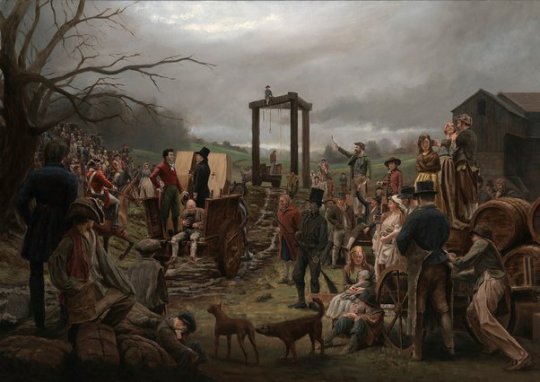
This is Tyburn Tree, London’s largest site for public hangings from at least 1177 until 1798, when Newgate Prison became the new home for this macabre form of entertainment.
Out of the thousands executed there, one famous case was that of a William Duell. Indicted on charges of rape, robbery and murder, the 17-year-old Duell was eventually convicted of rape and sentenced to death. On a bitter winter’s day in November 1740, the condemned youth faced the noose at Tyburn alongside four others.
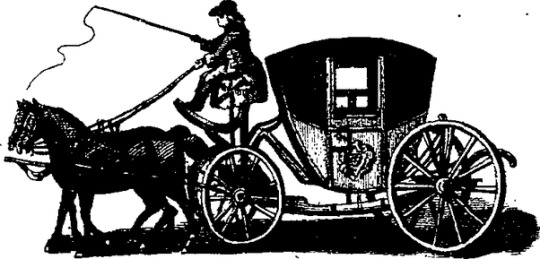
After being hanged for twenty-two minutes, he was cut down and his body hauled into a hackney coach, to be taken to Barber-Surgeons’ Hall, where his body would be dissected for the purposes of medical research.
The surgeon and his assistants got a surprise when they placed the corpse on the slab though… it groaned. Further examination revealed some other signs of life, so they let several ounces of blood and after a while, he was able to sit up, though it was a while before he could do anything else.

He was then transported to Newgate Prison where he was held up in a cell and given broth and covers to keep him warm. In a matter of days he was reported to be back to full health, and had developed a strong appetite. During this time, the powers that were had to decide what to do with him.
After all, he was legally dead.
In the end, to avoid making a mockery of the law and to curb the spread of the knowledge that it was possible to survive hanging, they decided to sentence him to transportation. He was sent to North America and reportedly lived out the rest of his life in Boston, before dying at around the age of eighty-two.
1K notes
·
View notes
Photo

Robert Dudley, 1st Earl of Leicester
Robert Dudley, 1st Earl of Leicester (l. c. 1532-1588 CE), was a high-ranking courtier who rose to become a favourite of Elizabeth I of England (r. 1558-1603 CE). Rumours abounded that Dudley sought to marry the queen, and their relationship may well have gone beyond that of monarch and minister. Holding all manner of titles and estates, Dudley pushed for a more aggressive approach to foreign policy but came unstuck in two failed expeditions to help rebel Protestants in the Netherlands between 1585 and 1587 CE. Dashing and entertaining, the Earl of Leicester accompanied the queen on many of her annual tours around England and maintained a special place in her affections until his death in September 1588 CE.
Early Life
Robert Dudley was born c. 1532 CE, the son of John Dudley, the Duke of Northumberland. The duke had been executed by Mary I of England (r. 1553-1558 CE) for not supporting her succession. Robert had himself been accused of being involved in the plot to have Lady Jane Grey succeed Edward VI of England (r. 1547-1553 CE), which indeed he had been. Robert was sent by his father to capture Mary during the coup but the soon-to-be queen had by then already fled to East Anglia. Dudley was imprisoned in the Tower of London and even sentenced to death but he was later pardoned by Mary. This was third time lucky for the Dudleys as Robert's grandfather, like his father, had been executed for treason in 1510 CE. Despite his compromising family history and disastrous career start, the handsome and ambitious Robert Dudley would rise to the very pinnacle of English politics.
In 1550 CE Dudley married Amy Robsart, a decision he perhaps regretted later in life. Dudley and Princess Elizabeth, Mary's half-sister, were friends before the former became queen in 1558 CE. In 1557 CE Dudley fought with distinction against the French at the Battle of Saint-Quentin. In 1559 CE, after Elizabeth became queen, Dudley was appointed Master of the Horse, a highly honoured position that put him in charge of his monarch's stables, transport, and hunting hounds. Another honour was to be made a member of the distinguished Order of the Garter, a relic of medieval chivalry which continues today.
Continue reading...
76 notes
·
View notes
Text
@jegulus-microfic | january 2, prompt: fire | word count: 1.575 featuring older ceo regulus black and younger intern james potter
“A truffle wagyu burger with hand-cut fries? What does that even fucking mean?!” James shouts into the receiver as he winds through the busy masses of bodies crossing the roads, the traffic light across blinking for him to hurry. “Can’t I pick up something for him from Burger King or something? You know, like a normal human being?”
On the other end of the line, Barty snorts a derisive sound. “Yeah, you try feeding him cheap chain franchise slob and see how that plays out for you. The fucker thinks Versace is a low-class brand, James. He probably doesn’t even know what the inside of a Burger King looks like. Besides, that place is fire. They have good shit.”
Groaning, James picks up the speed and sets out for a sprint, having missed the bus to Howick and resorted to the most reliable way of transport—his two sets of healthy, always moderately trained legs.
“Are you running? You better not be fucking running, Potter. You’re going to come back all sweaty and with creases in your cheap-ass button-up and then I’m going to be the one getting shit for not driving you and ruining the image of Regulus Black’s executive assistant—”
“Suck a dick, Barty,” James bites back after barely evading a car, its tires screeching at him in warning. He throws the driver an apologetic smile.
“I’m serious. You meal-prepped, Potter! Asked where the fucking office microwave is, are you out of your mind? Lunch is on company credit, for fuck’s sake. You’ve got an image to uphold now you’re working for Black Enterprises!”
“The cafeteria is too rich for my taste. Besides, I like meal-prepping. It’s calming.”
“Your fucking tuna stinks up the place.”
“Maybe that’s just your big bullshitting mouth.”
“Listen here, you piece of—”
“Oops, entering a tunnel, hear that?” James cups a hand over the receiver and makes a low, grating sound—mimicking the static rasp of a bad cellular connection. “See you!”
He tucks away the phone before entering Beauxbatons, the restaurant Barty had told him to go to because Regulus was craving his guilty snack, which, to James, sounded like an item right off a witch’s menu. Then again, he was a poor twenty-three-year-old who had just had a gap year fresh out of university, lived in a run-down apartment tucked in Southern London, and knew nothing of the expensive tastes a man like Regulus Black possessed. Thirty-something years old and not a single skin blemish. Must be all the fucking truffle and caviar and whatever Boiron guava puree he eats.
“Welcome,” one of the employees asks. Of course, all of the staff are also wearing pristine clothes and have perfectly sleeked-back hair.
“Hi,” James answers, now all too conscious of the developing sweat marks below his armpits and the dampness cooling on his back. “I’m, uh, here to pick up lunch? Sorry, I forgot my order so let me have a peek at my messages…”
The employee blinks like James has grown a second head. “Take-away? Sir, this is a dine-in restaurant.”
Good thing James has come prepared. He shuffles through the contents of his bag, phone in the other hand and tip of his tongue peeking out in full concentration. “Oh, that’s alright. I brought something to carry it with me. I also got some Tupperware if you don’t mind rinsing it beforehand.”
“No, sir, it’s not a matter of containers,” the employee starts, her lips pursed into a tight line. “We don’t do takeaways.”
James stops and frowns, bag half slung over his shoulder. “Isn’t this Beauxbatons?”
“It is.”
“My boss sometimes has people pick up his lunch here.”
“You must be mistaken… We do not lend any type of service like that.”
James sighs. Great. Amazing. Just what he needed. “Right. Do you mind if I make a call? I’m sorry, there must have been a mistake then.”
The employee, undoubtedly taking pity on him and his disorderly state that suggests he’s been running the past ten minutes, nods. “Of course.”
Heaving a sigh, James scrolls through his contact list and taps on ‘Regulus’, never mind that he has been firmly instructed to only call him during emergencies. But considering the sort of day he’s been having, he considers this one.
Regulus picks up after the third ring. “Potter?”
It’s been two weeks and he still won’t fucking call him by his name, going off on tangents about formal office conduct and etiquette. Potter this, Potter that, bridling when he’s called by his first name for a change in an environment that would kiss the soles of his feet if he’d ask. “Hi, I’m at the place you sent me the address of but they don’t do takeaways so I wanted to know what you want to eat. You cool with Wagamama?”
There’s a pregnant pause—all too telling of how Regulus is probably taking a deep breath and doing the thing where he either pinches the bridge of his nose or rubs his eyebrows. “Have you mentioned the takeaway is for me?”
“No, I haven’t.” What difference would it make, James wants to ask. But in a world where Regulus Black is pretty much revered, he is confident it would make a little difference at least.
“Do that, Potter.”
James rolls his eyes before returning his attention to the employee. “He wants you to know his name is Regulus, by the way.”
Her eyes widen. “Reg—Do you mean Mr. Black?”
James clicks his tongue. “That the one.” The employee doesn’t look convinced and James holds up his hand just above his chest. “About this tall? Curly black hair? Probably in one of today’s morning tabloids, not hard to miss. I could put him on speaker if you’d like?”
There’s the frantic wave of her hands, head shaking vigorously. “Oh! You should have told me from the start, Sir. Please, what would Mr. Black like to eat for lunch? I—I’m sorry. We are very exclusive in our service and are most honored Mr. Black has once again chosen our humble establishment—”
“Just,” James sighs, skimming over the menu laminated standing on an easel by the entrance, not possessing the energy to listen to someone go off on tangents about his boss again. Not like he does so internally at night, anyway. Absolutely not. “A truffle wagyu burger with hand-cut fries.”
“Not fries, a salad—” Regulus reminds him over the phone, but James has decided that he will just about eat whatever James decides on.
“Potter—” Regulus tries again and James flat-out hushes him. To his surprise, Regulus actually shuts up.
The employee nods, over-excited. “Oh, of course, an excellent choice. How would Mr. Black like it to be cooked?”
James shrugs. “I don’t know, on a grill?”
There’s a faint garbled noise coming from Regulus that James will definitely tuck away in his memory.
But the employee is too thrilled to be serving someone as pompous as Regulus to notice the lack of culinary terminology James possesses. “Oh, I meant the cook of the meat!”
“The cook of the meat?” James repeats. “I don’t know, whoever is on shift? Regulus, who do you want to cook your burger?”
The employee makes a high-pitched sound at the same Regulus sighs in a very exaggerated, exhausted manner. “Just tell them medium rare.”
“Medium? What is this, a video game difficulty?”
“Medium rare!” the employee chirps, her smile wry. Strands of hair stick out of the previously perfectly pulled-back bun like the situation has created plenty of static to dishevel her updo. “One medium rare wagyu—”
“Don’t forget the fries,” James adds, unable to fight off the grin cleaving his face. This, he loves most—fucking with rich people. ‘Who do you want to cook your meat?’ he’s a genius for that one, an absolute innovative mastermind. Make him head of corporate next at this rate.
“You had to call me for this?” Regulus asks him as James watches the poor girl scurry off to the back, undoubtedly to ring in the order and gush about the perfect, rich, hot-looking Regulus Black on the phone by the restaurant’s hallway.
“It was an emergency. I get you the wrong order and you, I dunno, bite off my head like Miranda Priestly.”
“I don’t know a Miranda Priestly.”
“No? Shame. Would’ve loved her, a real feisty woman that one. She works in the fashion industry, though.”
“Potter.”
James tries not to bark out a laugh. He can’t help it, Regulus is just too easy. “Yeah, I’ll get you your overtly expensive A3-grade cut of meat that could pay for my weekly rent. Didn’t take you for the type of man to get burgers, by the way.”
“That’s why I’m asking employees of a lower tax bracket to pick them up for me.”
Okay, that’s kind of funny. Regulus Black can be fucking funny if he wants to, he just rarely chooses to. James barely masks his snort at it. “Got me there, boss.”
“Get a cab back to the office. And stop calling me boss.”
“My bad, Sir,” James drawls, knowing that Regulus reacts particularly well to this specific formality.
A second of silence that stretches on for a little too long. James clears his throat, wondering if the line cut off. “Regu—”
“See you soon, Potter,” Regulus speaks, faster than usual, almost like he’s flustered, and with a strange pitch to his words before he hangs up.
#jegulus#james potter#regulus black#jegulus fanfiction#marauders#marauders au#jegulus microfic#starchaser#sunseeker#this one is for mil bc she plotted this w me so extensively#and also for cass <3 bc they synced w my brain today#ino microfic tag!
398 notes
·
View notes
Text

Robert: Father, Father! You got an express message!

Robert: Will you read it right now?
Matthew: O’ courshe. ‘hank you, Shir! (reads the message) Oh no! ‘oor Shon!
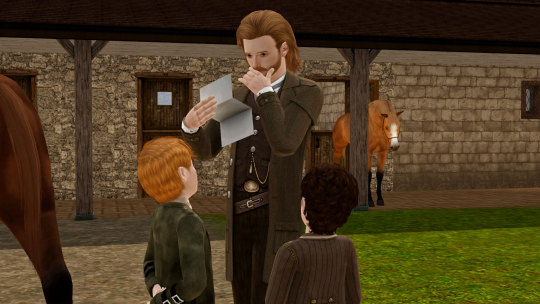
[Richard Brodie to Jonathan Brodie (copy to Matthew McCarric):]
Lord Clarke for whom I’m working here in London has excellent sources of information in France. I was scrutinizing the papers for mentions of our French relatives and today I found that Uncle Delaroche, André and Baron de Montigny have been arrested. I can’t leave London myself, but I think I found a way for you to intervene. Lord Clarke wishes to start a collection of antiques. As the Duc de – was executed, his collection at Chateau Monlieu is for sale, and my employer is especially interested in the famous torso. I’m enclosing two diplomatic passports for safe conduct and transportation of a crate. That’s all I could get, but use them to try and get our kinsmen out of prison – if possible out of the country. Your best bet is to claim the Delaroches are Scottish subjects – their ancestors belonged to the exiled Stuart court after all. Best of luck! Richard
41 notes
·
View notes
Text
The Sign of Four: The Baker Street Irregulars
I'm rather behind with these and will be for a while.
London had many, many wharfs; the number topped out at around 1,700.
London would have had a huge number of boats and ships of varying types plying the Thames at this point, moving cargo and people back and forth - it could be quicker than going by horse depending on the traffic. Today, the number is far smaller, mostly consisting of tourist vessels, the Thames Clipper passenger services that are part of the TfL network and tenders carrying rubbish.
Coke is a hard, grey fuel created by heating coal or oil in the absence of oxygen. It produces much less smoke than regular coal, allow most homes and other operations didn't use it at this point. Hence the yellow fog...
It takes quite a while to warm up a steam boiler; you're generally looking at two to three hours for a steam locomotive before it can be used.
A wherry is a small boat with a sail and oars used for transporting people on rivers like the Thames. The long bow makes it easier for passengers to get on and off on a shoreline without getting their shoes wet.
Millbank Penitentiary was a prison that had formerly held those due to be transported to Australia and then became a local prison, followed by a military one. It had ceased to hold prisoners in 1886, closed entirely in 1890 and was mostly demolished soon after that. Many of its red bricks were reused for housing as the Millbank Estate and the Tate Britain is also on the site.
"A tanner" is six pence, or half a shilling. "Three bob and a tanner" means 3 shillings and six pence, which is what Wiggins paid for the bus tickets.
Not sure about the whole sandal thing, but the Special Operations Executive, themselves known as the "Baker Street Irregulars" due to their HQ's location, developed special overshoes in the shape of bare feet to deceive the Japanese into thinking they were barefooted locals when leaving footprints.
Bushmen is an older and still sometimes used term for the San people of southern Africa, one of the oldest hunter-gatherer peoples on the planet. Much of the rest of the stuff about height seems a lot of racist rubbish.
#letters from watson#sherlock holmes#history#factoids#acd canon#the sign of four#sign#hungry like the wharf
23 notes
·
View notes
Text
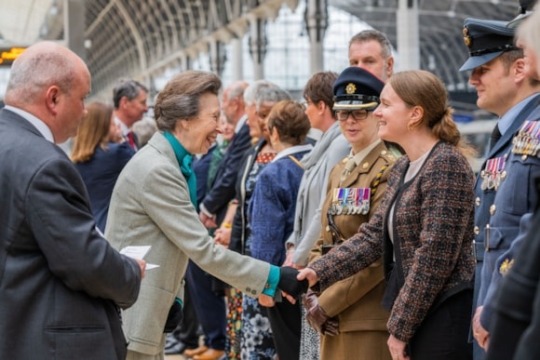
Great Western Railway celebrates The Princess Royal’s lifetime of dedicated service by naming train in her honour
Great Western Railway has named a train after HRH The Princess Royal in recognition of her support for more than 300 charities, organisations and military regiments in the UK and overseas.
Representatives from a host of those organisations joined guests at London Paddington on Thursday 2nd May as Intercity Express Train 800024 was named in honour of Her Royal Highness.
Her Royal Highness was joined at London Paddington by husband Vice Admiral Sir Tim Laurence, a member of the GWR Advisory Board.

After the unveiling, The Princess Royal was introduced to guests including the Secretary of State for Transport, Mark Harper MP, former Prime Minister Theresa May and Transport for London Commissioner Andrew Lord.
Mark Hopwood, Great Western Railway Managing Director, said: “Naming trains has been a tradition on the railway, and especially on the Great Western Railway, since the earliest days of train travel.”
“Today GWR proudly continues this tradition, recognising and celebrating inspirational individuals who have shaped the communities and the nation. Her Royal Highness has dedicated a large part of her working life to official engagements and visits and we are delighted to recognise this immense contribution by carrying her name on the side of this Intercity Express Train.”

Transport Secretary, Rt Hon Mark Harper MP, said: “I’m delighted to see one of GWR’s trains named after Her Royal Highness The Princess Royal in recognition of her remarkable commitment to public service.
“Her Royal Highness has made a significant contribution to so many important charities, events and public services so it gives me great pride to celebrate this through one of the greatest traditions on our railways.”
Inspired by the heritage of GWR’s King George V locomotive, two sides of a coin appear on the side of GWR’s named Intercity Express Trains.
With the Coat of Arms of the GWR on one side of coin, the other will include an illustration of The Princess competing at the 1976 Montreal Olympics. Seated on the Queen’s horse, Goodwill, Her Royal Highness was taking part in the equestrian three-day event – the first member of the Royal Family to feature in the Olympics.
HRH went on to play a part in London’s successful bid to host the 2012 Olympic Games and today brings insight and experience to her role as a British member of the International Olympic Committee, as well as being President of the British Olympic Association.
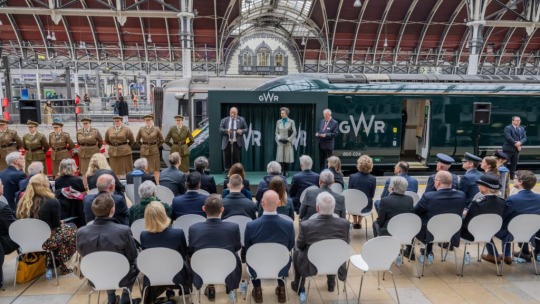
Annamarie Phelps CBE, Vice-Chairman of the British Olympic Association, said: “HRH The Princess Royal is synonymous with British Olympic sport and the British Olympic Association. Having competed as an Olympian, she also holds the unique record of being an IOC member, having led an international sport federation and, of course, being the mother to another Olympian, Zara Tindall. We are delighted to join her today to celebrate the naming of this train in her honour.”
The Princess has been President of Save the Children UK since 1970, visiting projects in many countries including China, Cambodia, Botswana, Madagascar and The Philippines.
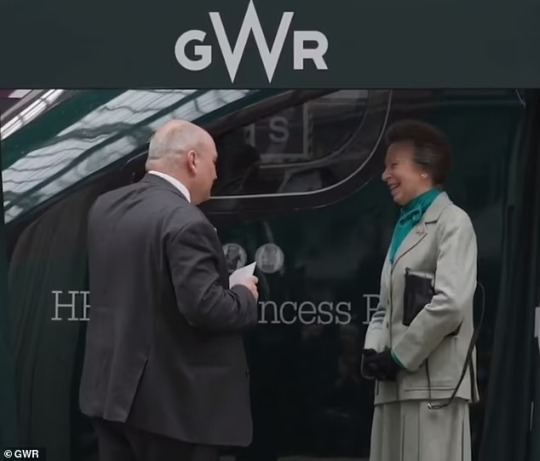
Gemma Sherrington, Interim Chief Executive of Save the Children, said: “We are delighted that Her Royal Highness The Princess Royal is being honoured by Great Western Railway for her lifelong charitable commitments. The Princess Royal has supported the work of Save the Children for over 50 years and as our Patron has worked tirelessly to support us, visiting teams in the UK and around the world and regularly meeting with our inspirational fundraisers and volunteers.
“We continue to be incredibly grateful for The Princess Royal’s support to help us continue to deliver lasting change for children and their families in the UK and across the globe.”
HRH has been closely involved with the creation of several charities, including The Princess Royal’s Trust for Carers (now Carers Trust), Transaid and Riders for Health, and has been Patron of the Motor Neurone Disease Association since 2008.
Tanya Curry, chief executive of the MND Association, said, “HRH The Princess Royal has offered steadfast support to the MND Association for more than 16 years and is a remarkable advocate for people with motor neurone disease, a terminal illness which affects more than 5000 people in the UK at any one time.
“We are incredibly grateful to Her Royal Highness for her unwavering dedication throughout her time as Royal Patron of the MND Association, and we are delighted her commitment to charitable causes is being recognised in this way.”

#what an honour!!!#always there to support his wife#princess anne#princess royal#tim laurence#timothy laurence
23 notes
·
View notes
Text
Driver for Hire for a Day - Luxury Chauffeur Driven Cars
Driver for Hire for a Day Seamless, Flexible, and Luxurious Travel Enjoy the freedom and convenience of having a professional chauffeur at your service for an entire day. Whether you’re attending back-to-back meetings, exploring London’s landmarks, or running errands in style, our Driver for Hire for a Day service is designed to make your day stress-free, flexible, and exceptionally…

View On WordPress
#airport cab service#airport taxi cab services#airport taxi heathrow terminal 5#airport taxi service#Airport transfers London#booking airport transfers#bristol taxi airport#cab gatwick#cabs barnet#call taxi cab#chauffeur service london#executive car service london#gatwick heathrow transfer#gatwick transfer#Ground Transportation London#heathrow airport transfer#heathrow transfers#lhr transfer#local taxi cab service#london heathrow transfer#london mini cab#luton airport cabs#luton airport taxi#Luxury Car Hire London#luxury chauffeur hire london#mini cab london#minicab heathrow terminal 5#minicab london#pre booked taxi#private transfer
0 notes
Text
Dulag Luft
Places of Interest in Masters of the Air
Masterlist
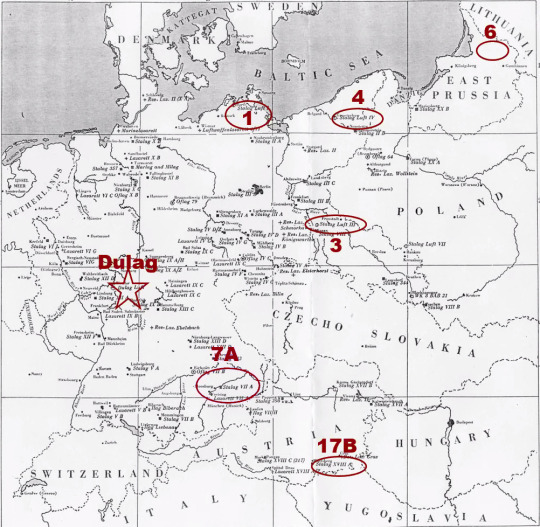
When captured by the Germans, Allied airmen would be sent to Dulag Luft, the interrogation and transit POW camp for the Luftwaffe that was just northeast of the city of Frankfurt. This is the camp where Cleven and Egan were held in solitary confinement for weeks before being transported right outside Sagan to Stalag Luft III.
Dulag Luft interrogators were some of the best in the business, and Miller describes them in Masters of the Air as "deeply skilled specialists who preferred methods more subtle than a rubber hose (Miller, 2007, pg. 386)." Many of these interrogators had spent time in America and were fluent in English. The conversation "would begin by offering him chocolate and cigarettes and then draw him into some light banter about American baseball or movies.... [the conversation] became so congenial that many airmen were unaware that the interrogation had begun (Miller, 2007, pg. 386)."
The interrogators had thick folders on each man and their bomb group. They gathered their information from intercepted communications, Stars and Stripes newspaper articles, and anything else they could get their hands on. It unnerved some of the men that the Germans knew such specific details of themselves, their families, and their bombardment groups. The conditions were terrible, and many of the officers were subjected to solitary confinement for weeks at a time.

Miller writes about this in his book:
“Downed Allied airmen felt safer in the hands of the German military than they did with the local citizenry they had bombed. Luftwaffe police and interrogators were in official charge of captured airmen, and their tactics for extracting information were rough but rarely barbaric. After being captured, Lou Loevsky was shipped with other downed American airmen to Dulag Luft, the Luftwaffe interrogation center for Allied airmen at Oberursel, a suburb of Frankfurt am Main. At one point in his interrogation a smiling Luftwaffe major asked Roger Burwell why the men in his 381st Bomb Group at Ridgewell had not yet fixed the broken clock in their officers club. Airmen who refused to provide military or personal information were usually threatened verbally. Some were told that their families would not be informed they were alive and "safe" until they began to cooperate; men captured without identification tags were warned that they could be turned over to the Gestapo to be executed as spies. One stubbornly tight-lipped officer - married and with children - was told that if he persisted in his obstinacy, a report would go out the next day from the German radio station in Calais that the night before he was shot down he had been at the Grosvenor House in London, in room 413, with an attractive blond woman. Knowing that the information was exactly correct, the major is reported to have fainted on the spot. Prisoners were also softened up by the appalling conditions at Dulag Luft: the tomblike isolation, the starvation rations, and the mice that ran free in the dank cells, and crawled in prisoners' pockets searching for food. Sometimes the promise of a shower, a shave, and a hot meal was sufficient to loosen a man's tongue. The guards also fiendishly manipulated the temperatures in the cells, shutting off the electric wall heaters in the winter and turning them up to intolerable levels, to 130 degrees, in warmer weather. Hundreds of airmen arrived at Dulag Luft wounded and were denied medical treatment, a flagrant violation of the Geneva Conventions regarding prisoners of war. "My interrogator said he could see that I was injured and needed treatment and that my being stubborn would only delay my being sent to a hospital," Roger Burwell re-called. On the other hand, high-ranking Allied fliers believed to possess specialized military information were taken on hunting trips or invited to raucous drinking parties with German officers.
Most of the information was gathered from Allied sources by Dulag Luft's efficient staff, who scrutinized American magazines and newspapers brought in from neutral Portu-gal, including Stars and Stripes, a rich source of hometown information about airmen. Additional information, including logbooks, briefing notes, and airmen's personal diaries, was gathered from clothing and other personal belongings found in the charred wreckage of bombers. These documents often contained highly secret data about flight patterns, the effectiveness of German defenses, and targets marked for future bombing. An officer in the American Air Force's Counter Intelligence Corps noted at the time that 'it was not uncommon for large German manufacturers to ask the Luftwaffe if their factories were on the list, and if so, when they could expect to be bombed." German linguists also monitored Allied airmen's wireless communications. According to Hanns Scharff, the interrogators at Dulag Luft had at their disposal a copious file in which "nearly every single word spoken in the air from plane to plane or from base to plane or vice-versa was carefully noted." As Air Force counter-intelligence experts noted in their own secret files, "nothing in the way of documents, written or printed, was too insignificant to merit close scrutiny" by the intelligence staff at Dulag Luft. A case in point is the airmen's ration cards. Every American flier in the European Theater received exactly the same kind of card, and there was nothing on the card to indicate where he was stationed. But investigators at Dulag Luft were able to identify an airman's bomb group by the way his card was canceled. At Thorpe Abbotts, for example, the clerks on duty in the PX marked the cards with a heavy black pencil. The PX counter was made of rough board. All the cards canceled there carried the impression of its distinctive pattern in the black pencil markings. The Air Force's Counter Intelligence Corps estimated that 80 percent of the information obtained by Dulag Luft was supplied by captured documents and monitored radio traffic, with the remainder coming from POW interrogations. After the war, when he was hired as an interpreter by the American military, Hanns Scharff estimated that all but twenty of the more than 500 airmen he questioned disclosed operational and tactical information that proved useful to the Luftwaffe. Few of these airmen, he emphasized, did it knowingly, or through intimidation or a conscious desire to improve the conditions of their confinement. "I suppose he got something out of me," said one flier, "but to this day I haven't the least idea what it could have been." After being released from Dulag Luft, Loevsky and several dozen other airmen were taken by tram to Frankfurt, where they were herded onto cattle cars and sent deep into German-occupied territory to Stalag Luft III (Air Camp number three), near the town of Sagan, a hundred miles southeast of Berlin, one of the half-dozen main POW camps operated by the Luftwaffe hence the term "Luft," or air-for Allied airmen (Miller, 2007, pg. 387-89)."
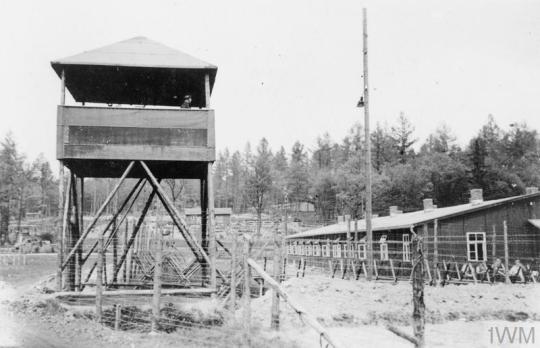
Dulag Luft was the first stop in a sequence of camps and transportation depots that downed airmen had to go through. Hopefully, we'll get to see more of the camp in the show! We're less than a month away, guys! The wait is almost over!!

tag list: @ronald-speirs @footprintsinthesxnd @georgieluz @sweetxvanixlla @coco-bean-1218 @gloryofwinter
message or comment if you want to be added to the tag list! <3

#gale cleven#john egan#masters of the air#gale buck cleven#hbo war#major buck cleven#major john egan#rosie rosenthal#1940s#8th air force#stalag iii#stalag luft iii#dulag luft#pow#100th bomb group#eighth air force#about masters of the air#road to masters of the air#donald miller#masters of the air book
37 notes
·
View notes
Note
Is the story about anne boleyn's ladies personally burying her and binding her legs to prevent her corpse being desecrated true??
✨ terfs/zionists fuck off ✨
her ladies would have been obligated to transport her remains to the chapel or at peter ad vincula. the claim that her ladies distrusted men to handle her comes from lancelot de carles: “the head and body were taken up by the ladies, whom you would have thought bereft of their souls, so languid and weak were they with anguish, but, fearing that their mistress might be handled unworthily by inhuman men, they forced themselves to do this duty”. however, i think certain details about anne’s execution are suspect — that is not to say they’re all untrue, but i don’t think they should be uncritically accepted as unbiased and wholly accurate. in this instance, lancelot de carles was an eyewitness, but likely not privy to the reasoning for the ladies tending to her remains… did they tell him/witnesses they did not trust men to handle anne, a la the scene in wolf hall? we can directly compare anne’s execution to katherine howard’s, and in the detail of ladies having the responsibility of handling the body, both executions are identical: “her [katherine’s] body was then covered with a black cloak and her ladies took it away” (chapuys). it seems to me that the handling of the executed queen’s body was considered a job for the women serving her, rather than a distinct act of loyalty/compassion such as de carles suggests.
moreover, i think a lot has been read into a very small detail, and the way it has been sensationalised is… well, it’s very tiktok.
no, there is no contemporary basis for the claim that they bound anne’s legs (what would the need be? she was immediately interred, and i doubt graverobbing and/or necrophilia unto the remains of an anointed queen was particularly feasible inside a royal fortress as fortified as the tower of london…) but i have seen it referred to in the same posts/videos that associate the treatment of anne’s body by anne’s ladies with the anecdote of wives of samurai tying their legs together prior to committing suicide in japan, which i think is where this specific detail comes from.
simply put: japanese history is not english history. there are unique nuances to the act of female seppuku/jigai. the detail of binding legs seems to have as much to do with a presentation of honour as it does a security measure: "women often tied together their knees so that their bodies would be found in a decorous position, and their honor would be preserved". this is not to undermine the threat of necrophilia to female cadavers, but it's hugely reductive to simplify ritual suicides and the culture/history surrounding that as a point of comparison, and i’m uncomfortable with the desire to sensationalise and sexualise anne boleyn’s execution, frankly.
likewise:

it’s not true. there’s no evidence that katherine’s body was deliberately destroyed. we don’t need to invent historical misogyny and violence against women. we have real examples throughout history and those histories deserve acknowledgement. for example: people frequently reference the violations of katherine parr’s body in these conversations but it is anne — whose body never suffered any violations — who gets centred in them. consider, instead, this article about katherine parr’s afterlife.
9 notes
·
View notes